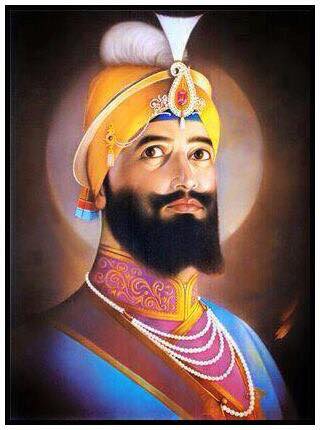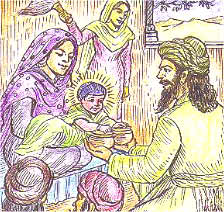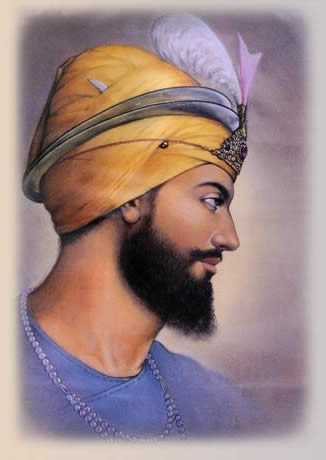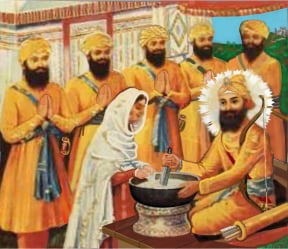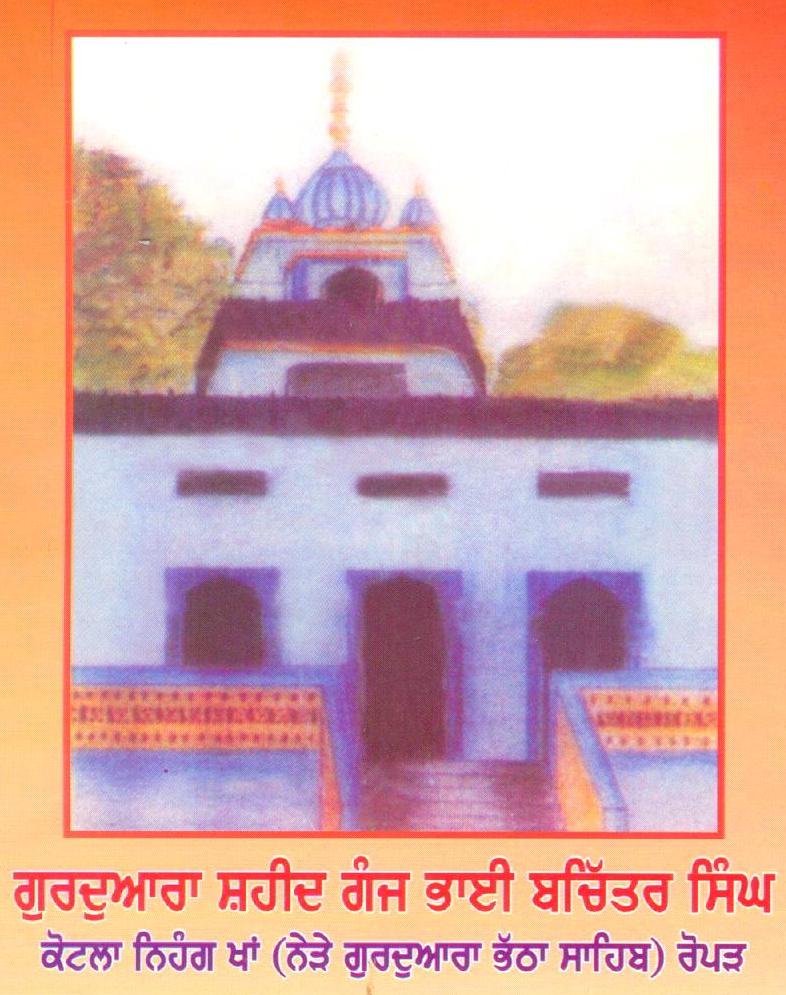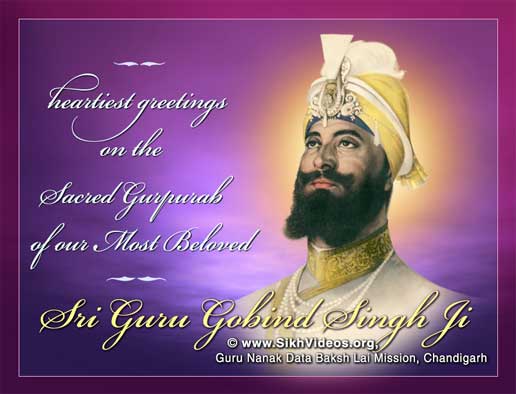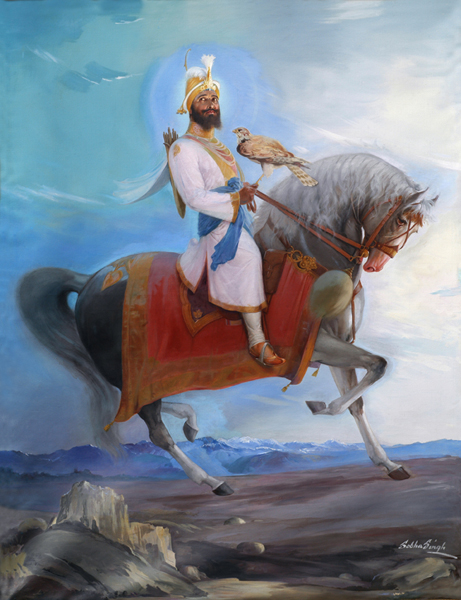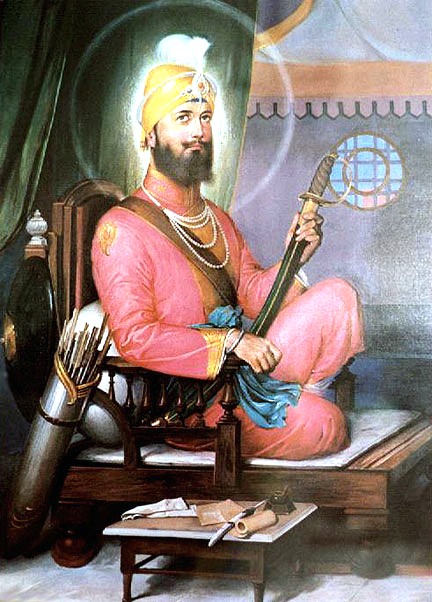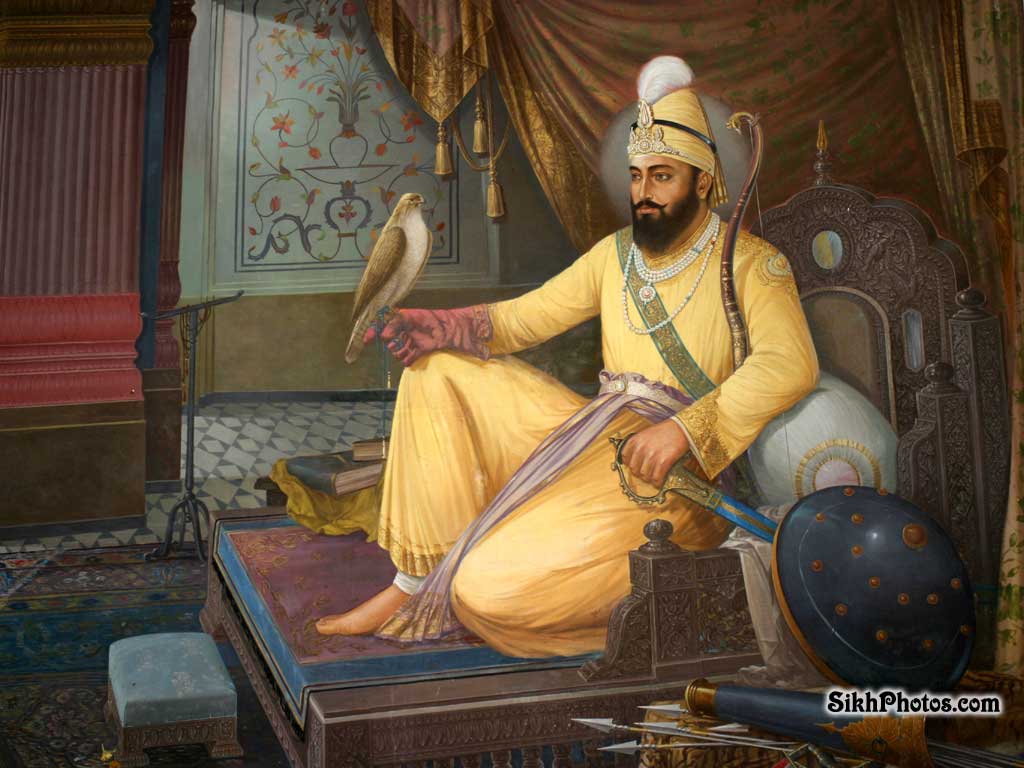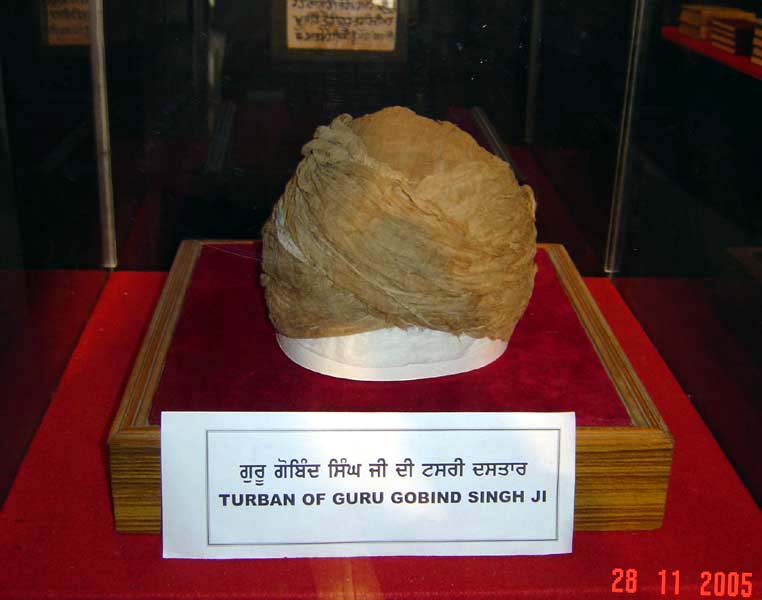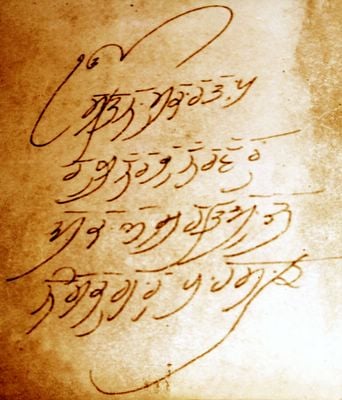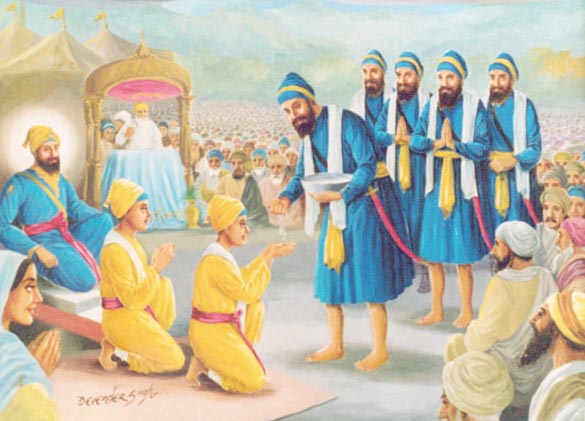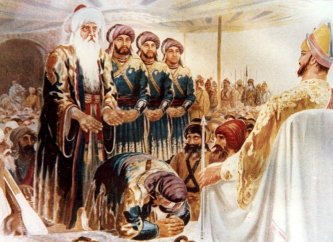Guru Gobind Singh
| Guru Gobind Singh (1667 to 1708) | |
| Full Name : | Gobind Das |
| Personal Details | |
| Birth : | Friday, January 5, 1667 in Patna, Bihar, India |
| Guruship : | 1675 to 1708 |
| Joti Jot : | Thursday, 21 October, 1708 at Nanded |
| Family | |
| Parents : | Guru Tegh Bahadur & Mata Gujri |
| Brother/Sisters : | -N.A- |
| Spouse : | Mata Jeeto, Mata Sundri, and Mata Sahib Kaur. |
| Children : | Zorawar Singh, Ajit Singh, Jujhar Singh, Fateh Singh |
| Other Details | |
| Bani in GGS: | Recomposed the Sri Guru Granth Sahib Ji at Damdama Sahib in 1706 |
| Other Info: | Wrote Dasam Granth and Sarabloh Granth Creation of Khalsa Panth Fought wars of defense for righteousness |
Guru Gobind Singh Ji (Gurmukhi: ਗੁਰੂ ਗੋਬਿੰਦ ਸਿੰਘ) (January 5, 16671 - 21 October, 1708), born "Gobind Das" at Patna Sahib, Bihar, India, was the tenth and last of the human form Gurus of Sikhism. He became Guru on November 24, 1675 at the age of nine, following the martyrdom of his father, the ninth Guru, Guru Tegh Bahadur Ji.
A divine messenger, a warrior, a poet, and a philosopher, Guru Gobind Singh Ji molded the Sikh religion into its present shape, with the institution of the Khalsa fraternity, and the completion of the sacred scripture, the Guru Granth Sahib Ji, in the final form that we find today. Before leaving his mortal body in 1708, Guru Gobind Singh decreed the Guru Granth Sahib Ji as the next and perpetual Guru of the Sikhs.
It may not be out of context to consider that throughout the chronicles of human history, there has been no individual who lived a life more inspirational than Guru Gobind Singh Ji. He is variously revered as Sarbans Dani (the merciful donor, who sacrificed his all), Mard Agamra (man without any parallels), Shah-e-Shahenshah (emperor of emperors), Bar do Alam Shah (ruler of both worlds), amongst others.
"If we consider the work which (Guru) Gobind (Singh) accomplished, both in reforming his religion and instituting a new code of law for his followers, his personal bravery under all circumstances; his persevering endurance amidst difficulties, which would have disheartened others and overwhelmed them in inextricable distress, and lastly his final victory over his powerful enemies by the very men who had previously forsaken him, we need not be surprised that the Sikhs venerate his memory. He was undoubtedly a great man." (W, L. McGregor)
It is said that after the martyrdom of his father, Guru Tegh Bahadur, the tenth Master declared that he would create such a Panth (community/society), which would challenge the tyrant rulers in every walk of life to restore justice, equality and peace for all of mankind. Via institution of the Khalsa in 1699, Guru Gobind Singh Ji infused the dual spirit of a saint and a soldier in the minds and hearts of his followers to fight oppression in order to restore righteousness (Dharma) and to uplift the down-trodden people in this world.
As a prophet, the Guru is unique. His teachings are very scientific and most suitable for all times. Unlike many other prophets he never called himself God or 'the only son of God.' Instead he called all people the sons of God sharing His Kingdom equally. For himself he used the word 'slave' or servant of God.
"Those who call me God, will fall into the deep pit of hell. Regard me as one of his slaves and have no doubt whatever about it. I am a servant of the Supreme Being; and have come to behold the wonderful drama of life."
Extracts from Guru Gobind Singh's writings;
"God has no marks, no colour, no caste, and no ancestors, No form, no complexion, no outline, no costume and is indescribable.
He is fearless, luminous and measureless in might. He is the king of kings, the Lord of the prophets.
He is the sovereign of the universe, gods, men and demons. The woods and dales sing the indescribable.
O Lord, none can tell Thy names. The wise count your blessings to coin your names." (Jaap Sahib)
Birth of a Star
A splendid Divine Light shone in the darkness of the night. Pir Bhikan Shah a Muslim mystic performed his prayers in that Easterly direction (instead of towards the West, contrary to his daily practice), and guided by this Divine Light, he travelled with a group of his followers until he reached Patna Sahib in Bihar.
It was here that Gobind Das was born to Mata Gujri in 1666. It is said that Pir Bhikan Shah approached the child and offered two bowls of milk and water, signifying both the great religions of Hinduism and Islam. The child smiled and placed his hands on both bowls. The Pir bowed in utter humility and reverence to the new Prophet of all humanity.
Gobind Das was born with a holy mission of which he tells us in his autobiography “Bachitar Natak” (Wonderous Drama). In it Guru Ji tells us how and for what purpose he was sent into this world by God. He states that before he came into this world , as a free spirit he was engaged in meditation in the seven peaked Hemkunt mountain. Having merged with God and having become One with the Unmanifest and the Infinite, God commanded him:
“I have cherished thee as my Son, and created thee to establish a religion and restrain the world from senseless acts. I stood up, folded my hands, bowed my head and replied,‘Thy religion will prevail in all the world, when it has Thy support’.”
Guru Ji describes the purpose of his coming to this world and why he emerged from the Supreme Reality in human form to carry out his Creator’s command :
“For this purpose was I born, let all virtuous people understand. I was born to advance righteousness, to emancipate the good, and to destroy all evil-doers root and branch.”
Early Life
Gobind Das's father, Guru Tegh Bahadur, the Ninth Guru, was then travelling across Bengal and Assam. Returning to Patna in 1670, he directed his family to return to the Punjab. On the site of the house at Patna in which Gobind Das was born and where he spent his early childhood now stands a sacred shrine, Sri Patna Sahib Gurdwara, Bihar.
Gobind Das was escorted to Anandpur (then known as Chakk Nanaki) on the foothills of the Sivaliks where he reached in March 1672 and where his early education included reading and writing of Punjabi, Braj, Sanskrit and Persian. He was barely nine years of age when a sudden turn came in his life as well as in the life of the community he was destined to lead.
Kashmiri Brahmins come to Anandpur
Early in 1675, a group of Kashmiri brahmins under the leadership of Pandit Kirpa Ram, mad in desperation by the religious fanaticism of the Mughals General, Iftikar Khan, (he had threatened them with forced conversion to Islam) visited Anandpur to seek Guru Tegh Bahadur's advice. Aurangzeb had ordered the forced conversion of all Hindus and thought that if the respected Kashmiri brahmans accepted Islam, others in the country would be easily converted. They had been given six months to decide or suffer the consequences. Time was running out!
As the Guru sat reflecting what to do, young Gobind Das, arriving there in company with his playmates, asked why he looked so preoccupied. The father, as records Kuir Singh in his Gurbilas Patshahi 10, replied, "Grave are the burdens the earth bears. She will be redeemed only if a truly worthy person comes forward to lay down his head. Distress will then be expunged and happiness ushered in."
"None could be worthier than you to make such a sacrifice," remarked Gobind Das in his innocent manner.
Guru Tegh Bahadur advised the brahmins to return to their village and tell the authorities that they would accept Islam if Guru Tegh Bahadur could first be persuaded to do so.
Father Guru's martyrdom
- Main article: Martyrdom of Guru Tegh Bahadur
Soon afterwards the Guru with a few followers proceeded to the imperial capital, Delhi. After watching the tortured deaths of three of his followers he, as well, refused to convert and was beheaded on November 11, 1675. The 13 year old Gobind Das, ordained as the next Guru before his father departed Anandpur, was formally installed as Guru Gobind Singh on the Baisakhi day of March 1676. In the midst of his engagement with the concerns of the community, he gave attention to the mastery of physical skills and literary accomplishment. He had grown into a comely youth spare, lithe of limb and energetic.
He had a natural genius for poetic composition and his early years were assiduously given to this pursuit. The Var Sri Bhagauti Ji Ki, popularly called Chandi di Var. written in 1684, was his first composition and his only major work in the Punjabi language. The poem depicted the legendary contest between the gods and the demons as described in the Markandeya Purana. The choice of a warlike theme for this and a number of his later compositions such as the two Chandi Charitras, mostly in Braj, was made to infuse martial spirit among his followers to prepare them to stand up against injustice and tyranny.
For the first 20 years or so of his life, Guru Gobind Singh lived peacefully at Anandpur practicing arms and exercises to complete his training as a soldier. He also studied Persian and Sanskrit and engaged 52 poets to translate the Hindu epics. Stories of ancient heroes were translated into Punjabi in order to create the martial spirit among the Sikhs. The Guru also wrote several compositions including Jaap Sahib, Akal Ustat and Sawayas during this period. He also established a Gurdwara at Paonta Sahib on the banks of the river Jamna.
Stay at Paonta Sahib
Much of Guru Gobind Singh's creative literary work was done at Paonta he had founded on the banks of the River Yamuna and to which site he had temporarily shifted in April 1685. Poetry as such was, however, not his aim. For him it was a means of revealing the divine principle and concretizing a personal vision of the Supreme Being that had been vouchsafed to him. His Jap Sahib, Swayas and the composition known as Akal Ustat are in this tenor.
Through his poetry he preached love and equality and a strictly ethical and moral code of conduct. He preached the worship of the One Supreme Being, deprecating idolatry and superstitious beliefs and observances. The glorification of the sword itself which he eulogized as Bhagauti was to secure fulfilment of God's justice. The sword was never meant as a symbol of aggression, and it was never to be used for self-aggrandizement. It was the emblem of manliness and self-respect and was to be used only in self-defence, as a last resort. For Guru Gobind Singh said in a Persian couplet in his Zafarnamah:
- "When all other means have failed, It is but lawful to take to the sword." (verse 22)
Martial training
During his stay at Paonta, Guru Gobind Singh availed himself of his spare time to practice different forms of manly exercises, such as riding, swimming and archery. His increasing influence among the people and the martial exercises of his men excited the jealousy of the neighbouring Rajput hill rulers who led by Raja Fateh Chand of Garhwal collected a host to attack him.
But they were worsted in an action at Bhangam, about 10 km north-east of Paonta, in September 1688. Soon thereafter Guru Gobind Singh left Paonta Sahib and returned to Anandpur. The Guru and his Sikhs were involved in a battle with a Mughal commander, Alif Khan, at Nadaur on the left bank of the Beas, about 30 km south-east of Kangra, in March 1691.
Describing the battle in stirring verse in Bachitra Natak, he said that Alif Khan fled in utter disarray "without being able to give any attention to his camp." Among several other battles that occurred was the Husain battle (20 February 1696) fought against Husain Khan, an imperial general, which resulted in a decisive victory for the Sikhs.
Following the appointment in 1694 of the liberal Prince Muazzam (later Emperor Bahadur Shah) as viceroy of north-western region including Punjab, there was however a brief respite from pressure from the ruling authority. In Sambat 1756 (1699 A.D), Guru Gobind Singh issued directions to Sikh sangats or communities in different parts not to acknowledge masands, the local ministers, against whom he had heard complaints. He asked the Sikhs to send their offerings directly to Anandpur.
Battle of Bhangani
- Main article: Battle of Bhangani
The Guru admonished hill Rajas including Raja Bhim Chand for giving their daughters to the Moghuls as tribute for holding their positions. His efforts at winning their support against Aurangzeb bore no fruit. On the contrary, the hill Rajas conspired with the Moghul armies to put down the power of Guru Gobind singh. They however faced defeat several times at the hands of the comparatively small Sikh Army. See www.info-sikh.com for more details
Battle of Nadaun (Hussaini Yudh)
The Masands
The Guru received various complaints against the priests, masands who robbed the poor Sikhs and misappropriated the collections. Guru Sahib abolished this order and severly punished the miscreants. Hereafter, the faithful were to bring their offerings directly to the Guru at the time of the annual Vaisakhi fair.
The Guru wanted to create a strong self-respecting community. He inspired the Sikhs with courage and heroism and a life of simplicity and hard work. He started an arms factory at Anandpur in order to manufacture swords and lances needed for his soldiers. Once when the Brahmins insisted that he should offer worship to goddess Durga in order to seal victory, he agreed and kept up the farce till nothing came out of it. At the crucial moment, the Guru unsheathed his sword exclaiming, “The sword is the Durga which will give us victory over our enemies.
Sikhs, he instructed, should come to Anandpur straight without any intermediaries. The Guru thus established direct relationship with his Sikhs. The institution of the Khalsa was given concrete form on 30 March 1699 when Sikhs had gathered at Anandpur in large numbers for the annual festival of Baisakhi.
Creation of the Khalsa
An open air diwan was held in Kesgarh Sahib at Anandpur. The Guru drew his sword and in a thundering voice said, "I want one head, is there any one who can offer me?"
This most unusual call caused some terror in the gathering and the people were stunned. There was dead silence. The Guru made a second call. Nobody came forward. There was still more silence. On the third call there raised Daya Ram, a khatri of Lahore who said, "O true king, my head is at your service."
The Guru took Daya Ram by the arm and led him inside a tent. A blow and thud were heard. Then the Guru, with his sword dripping with blood, came out and said, "I want another head, is there anyone who can offer?" Again on third call Dharam Das, a Jat from Delhi came forward and said, "O true king! My head is at thy disposal."
The Guru took Dharam Das inside the tent, again a blow and thud were heard, and he came out with his sword dripping with blood and repeated, "I want another head, is there any beloved Sikh who can offer it?"
Upon this some people in the assembly remarked that the Guru had lost all reason and went to his mother to complain.
Mohkam Chand, a calico priner/tailor of Dwarka (west coast of India) offered himself as a sacrifice. The Guru took him inside the tent and went through the same process. When he came out, he made a call for the fourth head. The Sikhs began to think that he was going to kill all of them.
Some of them ran away and the others hung their heads down in disbelief. Himmat Chand, a cook of Jagan Nath Puri, offered himself as a fourth sacrifice. Then the Guru made a fifth and the last call for a fifth head. Sahib Chand, a barber of Bidar (in central India), came forward and the Guru took him inside the tent. A blow and thud were heard.
The last time he stayed longer in the tent. People began to breathe with relief. They thought may be the Guru has realised "his mistake" and has now stopped.
The panj pyare
- Main article: Panj Piare
The Guru now clad his five volunteers in splendid garments. They had offered their heads to the Guru, and the Guru had now given them himself and his glory. When they were brought outside, they were in the most radiant form. There were exclamations of wonder and the sighs of regret on all sides. Now people were sorry for not offering their heads.
Since the time of Guru Nanak, Charan Pauhal had been the customary form of initiation. People were to drink the holy water which had been touched or washed by the Guru's toe or feet. The Guru proceeded to initiate them to his new order (Khande di Pauhal) by asking the five faithful Sikhs to stand up.
He put pure water into an iron vessel or Bowl (Batta of Sarbloh) and stirred it with a Khanda (two edged small sword). While stirring the water with Khanda, he recited Gurbani (Five Banis- Japji, Jaap Sahib, Anand Sahib, Swayas, and Chaupai). Sugar crystals called 'Patasas' which incidently the Guru's wife, Mata Sahib Kaur, had brought at that moment, were mixed in the water.
Amrit Sanchar
- Main article: Amrit Sanchar
The Guru then stood up with the sacred Amrit (nectar) prepared in the iron bowl. Each of the five faithful, by turn, each kneeling upon his left knee, looked up to the Master to receive the divine amrit. He gave five palmfuls of Amrit to each of them to drink and sprinkled it five times in the eyes, asking them to repeat aloud with each sprinkle, "Waheguru Ji ka Khalsa, Waheguru Ji Ki Fateh." (This means: Khalsa belongs to God and all triumph be to His Name) Then he anointed with five sprinkles in the hair.
In this way Amrit was administered to the five faithful from the same bowl. After that he asked them to sip Amrit from the same bowl to signify their initiation into the casteless fraternity of the Khalsa. All the five faithful were baptized in this way by the Guru who then called them the 'PANJ PYARE' or Five Beloved Ones.
He gave them the appellation of SINGHS (Lions) and they were named from Daya Ram to Daya Singh, Dharam Das to Dharam Singh, Mohkam Chand to Mohkam Singh, Himmat Chand to Himmat Singh, and Sahib Chand to Sahib Singh. The Guru then addressed them as the supreme, the liberated ones, pure ones and he called them THE KHALSA.
He then ordained them to do the following:
I. First they must wear the following articles whose names begin with 'K':
The 5Ks
- Main article: 5Ks
- 1. Kesh - unshorn hair. This represents the natural appearance of sainthood. This is the first token of Sikh faith.
- 2. Kanga- A comb to clean the hair.
- 3. Kachha - An underwear to indicate virtuous character.
- 4. Kara - A Iron bracelet on the wrist, a symbol of dedication to the Divine Bridegroom.
- 5. Kirpan - A sword symbolising dignity, power and unconquerable spirit.
II. They must observe the following guidelines:
- 1. Not to remove hair from the body.
- 2. Not to use Tobacco or other intoxicants (alcohol).
- 3. Not to eat or touch Kuttha (Halal or Kosher) meat of an animal (see Hukamnama by Sri Guru Gobind Singh ji to the Sikhs of Kabul).
- 4. Not to commit adultery- 'Par nari ki sej, bhul supne hun na jayo' (never enjoy, even in dream, the bed of a woman other than your own wife) (A supplementary ordinance was issued that any one who did not observe any of the four directives, must be re- baptized, pay a fine, and promise not to offend any more; or he must be excommunicated from the Khalsa).
III. They must rise at dawn, bathe, meditate on Gurmantar-'Waheguru', Moolmantar- the preamble of Japji, and recite five banis- Japji, Jap Sahib and Swayas in the morning; Rehras in the evening; and Kirtan Sohela at bed time at night.
IV. They must not worship idols, cemeteries, or cremation grounds, and must believe only in One Immortal God. The Guru further spelled out that they should practice arms, and never show their backs to the foe in the battle field. They should always be ready to help the poor and protect those who sought their protection. They were to consider their previous castes erased, and deem themselves all brothers of one family. Sikhs were to intermarry among themselves.
Guru asks for Amrit
After the Guru had administered Amrit to his Five Beloved Ones, he stood up in supplication and with folded hands, begged them to baptize him in the same way as he had baptized them. He himself became their disciple (Wonderful is Guru Gobind Singh, himself the Master and himself the disciple).
The Five Beloved Ones were astonished at such a proposal, and represented their own unworthiness, and the greatness of the Guru, whom they deemed God's Vicar upon earth. They asked him why he made such a request and why he stood in a supplicant posture before them. He replied," I am the son of the Immortal God. It is by His order I have been born and have established this form of baptism. They who accept it shall henceforth be known as the KHALSA.
The Khalsa is the Guru and the Guru is the Khalsa. There is no difference between you and me. As Guru Nanak seated Guru Angad on the throne, so have I made you also a Guru. Wherefore administer the baptismal nectar to me without any hesitation." Accordingly the Five Beloved Ones baptized the Guru with the same ceremonies and injunctions he himself had employed.
The rise of the Khalsa
The Guru was then named Gobind Singh instead of Gobind Das. Guru Gobind Singh was the first one to take Amrit from the Khalsa, the Five Beloved Ones. About 80,000 men and women were baptized within a few days at Anandpur. "The creation of the Khalsa was the greatest work of the Guru. He created a type of superman, a universal man of God, casteless and country less. The Guru regarded himself as the servant of the Khalsa. He said, "To serve them pleases me the most; no other service is so dear to my soul." The Khalsa was the spearhead of resistance against tyranny." (Miss Pearl, S. Buck)
The creation of the Khalsa created a sense of unity among the Sikhs and their supporters. This unity and the resulting perceived strength in the Sikhs did not go well with the local rulers. The continuous gatherings at Anandpur sahib and the presence of many thousands of the congregation, some armed with fierce weapons caused anguish with the surrounding hill Rajas. These developments most alarmed the caste ridden Rajput chiefs of the Sivalik hills. They perceived the Sikhs as lower caste beings who had posed no danger to their authority. However, the creation of the Khalsa changed that. Firstly, it disturbed their system of discrimination and division; secondly, they could see that the forces of the Guru were becoming dangerous in number and in armaments.
Siege of Anandpur
They hence rallied under the leadership of the Raja of Bilaspur, in whose territory lay Anandpur, to forcibly evict Guru Gobind Singh from his hilly citadel. Their repeated expeditions during 1700-04 however proved abortive. The Khalsa forces were too strong to be dealt with by the hill Rajas. They at last petitioned Emperor Aurangzeb for help. In concert with contingents sent under imperial orders by the governor of Lahore and those of the faujdar of Sirhind, they marched upon Anandpur and laid a siege to the fort in May 1705.
Over the months, the Guru and his Sikhs firmly withstood their successive assaults despite insufficient amounts of food resulting from the prolonged blockade. While the besieged (Sikhs) were reduced to desperate straits, the besiegers (governor of Lahore) too were exhausted at the courage of the Sikhs. At this stage the besiegers offered, on Oath (promise) of the Qur'an, safe exit to the Sikhs if they quit Anandpur. At last, the town was evacuated during a night of December 1705. But as the Guru and his Sikhs came out, the hill monarchs and their Mughal allies set upon them in full fury.
Sikhs "tricked" by the Mughals
In the ensuing confusion many Sikhs were killed and all of the Guru's baggage, including most of the precious manuscripts, was lost. The Guru himself was able to make his way to Chamkaur, 40 km southwest of Anandpur, with barely 40 Sikhs and his two elder sons. There the imperial army, following closely on his heels, caught up with him. His two sons, Ajit Singh (born. 1687) and Jujhar Singh (born. 1691) and all but five of the Sikhs fell in the action that took place on 7 December 1705. The five surviving Sikhs commanded the Guru to save himself in order to reconsolidate the Khalsa.
Guru Gobind Singh with three of his Sikhs escaped into the wilderness of the Malva, two of his Muslim devotees, Gani Khan and Nabi Khan, helping him at great personal risk. Guru Gobind Singh's two younger sons, Zorawar Singh (born. 1696), Fateh Singh (born.1699), and his mother, Mata Gujari Ji, also evacuated Anandpur but were betrayed by their old servant and escort, Gangu, to the faujdar of Sirhind, who had the young children executed on 13 December 1705. Their grandmother died the same day.
Guru escapes
Befriended by another Muslim admirer, Rai Kalha of Raikot,here Guru Gobind Singh gave his sword to Rai Kalha in gratitude for his kindness.(the sword is ingraved on both sides,on the right side is AKAL PURKH KI RACHCHIA HAM NE,SARAB LOH KI RACHCHIA HAM NE, EK ONKAR SATGUR PARSAD AUTAR KHAS PATSHAH 10. On the left side is,SARAB KAL KI RACHCHIA HAM NE, SARAB JIA KI RACHCHIA HAM NE.
(The sword was taken from the Toshekhana of Maharaja Ranjit Singh on 1st may 1849, along with other arms ie:SHUMASHER WA SIPAR(sword and shield),DAE-I-AHINEE(an iron weapon),NEZA(a lance),CHUKKUR-I-AHINEE(a circular missile weapon of iron),SHUMSHER TEGHAH(a seimitar),KULGHEE-E-KUCH(a crest of glass in silver case),BURCHEE(a small spear),BURCHHA(a large spear), by the east india company. These relics were sent to England under the orders of Lord Dalhousie.)
Guru Gobind Singh reached Dina in the heart of the Malva. There he enlisted a few hundred warriors of the Brar clan, and also composed his famous letter, Zafarnamah (the Epistle of Victory), in Persian verse, addressed to Emperor Aurangzeb. The letter was a severe indictment of the Emperor and his commanders who had broken their oath. They attacked Guru Gobind Singh once he was outside the safety of his fortification at Anandpur. Two of the Sikhs, Daya Singh and Dharam Singh, were despatched with the Zafarnamah to Ahmadnagar in the South to deliver it to Aurangzeb, then in camp in that town. From Dina, Guru Gobind Singh continued his westward march until, finding the host close upon his heels; he took position beside the water pool of Khidrana to make a last-ditch stand.
Brave Sikh women join fight
The fighting on 29 December 1705 was hard and desperate. In spite of their overwhelming numbers, the Mughal troops failed to capture the Guru and had to retire in defeat. The major part in this battle was played by a group of 40 Sikhs who had deserted the Guru at Anandpur during the long siege, but who, scolded by their wives at home, had come back under the leadership of a brave and devoted woman, Mai Bhago, to redeem themselves. They had fallen fighting desperately to check the enemy's advance towards the Guru's position. The Guru blessed the 40 dead as 40 mukte, i.e. the 40 Saved Ones. The site is now marked by a sacred shrine and tank and the town which has grown around them is called Muktsar, the Pool of Liberations.
After spending some time in the Lakkhi Jungle country, Guru Gobind Singh arrived at Talvandi Sabo, now called Damdama Sahib, on 20 January 1706. During his stay there of over nine months, a number of Sikhs rejoined him. He prepared a fresh text of Sikh Scripture, the Guru Granth Sahib, with the celebrated scholar, Bhai Mani Singh, who wrote the Guru's bani. From the number of scholars who had rallied round Guru Gobind Singh and from the literary activity initiated, the place came to be known as the Guru's Kashi or seat of learning like Varanasi (A city of northeast-central India).
Zafarnamah bears result
The Zafarnamah sent by Guru Gobind Singh from Dina seems to have touched the heart of Emperor Aurungzeb. He forthwith invited him for a meeting. According to history, the Emperor had a letter written to the deputy governor of Lahore, Munim Khan, to conciliate the Guru and make the required arrangements for his journey to the Deccan.
Guru Gobind Singh had, however, already left for the South on 30 October 1706. He was in the neighbourhood of Baghor, in Rajasthan, when the news arrived of the death of the Emperor at Ahmadnagar on 20 February 1707. The Guru there upon decided to return to the Punjab, via Shahjahanabad (Delhi). That was the time when the sons of the deceased Emperor were preparing to contest succession.
Guru helps Bahadur Shah
Guru Gobind Singh despatched for the help of the eldest claimant, the liberal Prince Muazzam, a token contingent of Sikhs which took part in the battle of Jajau (8 June 1707), decisively won by the Prince who ascended the throne with the title of Bahadur Shah. The new Emperor invited Guru Gobind Singh for a meeting which took place at Agra on 23 July 1707.
Emperor Bahadur Shah had at this time to move against the Kachhvaha Rajputs of Amber (Jaipur) and then to the Deccan where his youngest brother, Kam Baksh, had raised the standard of revolt. The Guru accompanied him and, as history says, he addressed assemblies of people on the way preaching the word of Guru Nanak. The two camps crossed the River Tapti in June 1708 and the Ban-Ganga in August, arriving at Nanded, on the Godavari, towards the end of August.
While Bahadur Shah proceeded further South, Guru Gobind Singh decided to stay awhile at Nanded. Here he met a Bairagi (a person who withdraws from the world), Madho Das, whom he blessed into a Sikh with the vows of the Khalsa, renaming him Gurbakhsh Singh (popular name Banda Singh). Guru Gobind Singh gave Banda Singh five arrows from his own quiver and an escort, including five of his chosen Sikhs, and directed him to go to the Punjab and carry on the campaign against the tyranny of the provincial overlords.
Plan to assassinate the Guru
Nawab Wazir Khan of Sirhind had felt concerned at the Emperor's conciliatory treatment of Guru Gobind Singh. Their marching together to the South made him jealous, and he ordered two of his trusted men with murdering the Guru before his increasing friendship with the Emperor resulted in any harm to him.
These two pathans Jamshed Khan and Wasil Beg are the names given in the Guru Kian Sakhian pursued the Guru secretly and overtook him at Nanded, where, according to Sri Gur Sobha by Senapati, a contemporary writer, one of them stabbed the Guru in the left side below the heart as he lay one evening in his chamber resting after the Rahras prayer. Before he could deal another blow, Guru Gobind Singh struck him down with his sabre, while his fleeing companion fell under the swords of Sikhs who had rushed in on hearing the noise. As the news reached Bahadar Shah's camp, he sent expert surgeons, to attend to the Guru.
Guru recovers but mission is at an end
The Guru's wound was immediately stitched by the Emperor's European surgeon and within a few days it appeared to have been healed. The injury had been contained and the Guru had made a good recovery. However, several days later, when the Guru tugged at a hard strong bow, the imperfectly healed wound burst open and caused profuse bleeding. It was again treated but it was now clear to the Guru that the call of the Father from Heaven had come. He prepared the sangat for his departure; instruction were given to the immediate main Sewadars and finally he gave his last and enduring message of his mission to the assembly of the Khalsa.
He then opened the Granth Sahib, placed five paise and solemnly bowed to it as his successor, GURU GRANTH SAHIB. Saying 'Waheguru ji ka Khalsa, Waheguru ji ki Fateh', he walked around the Guru Granth Sahib and proclaimed, "O beloved Khalsa, let him who desireth to behold me, behold the Guru Granth. Obey the Granth Sahib. It is the visible body of the Gurus. And let him who desires to meet me, search me in the hymns."
He then sang his self-composed hymn: "Agya bhai Akal ki tabhi chalayo Panth Sabh Sikhan ko hukam hai Guru manyo Granth Guru Granth Ji manyo pargat Guran ki deh Jo Prabhu ko milbo chahe khoj shabad mein le Raj karega Khalsa aqi rahei na koe Khwar hoe sabh milange bache sharan jo hoe."
Translation of the above:
"Under orders of the Immortal Being, the Panth was created. All the Sikhs are enjoined to accept the Granth as their Guru. Consider the Guru Granth as embodiment of the Gurus. Those who want to meet God, can find Him in its hymns. The Khalsa shall rule, and its opponents will be no more, Those separated will unite and all the devotees shall be saved."
Guru Granth Sahib becomes Guru
He, in grateful acknowledgement of the spiritual benefactions of the founder of his religion, uttered a Persian distich, the translation of which is:
"Gobind Singh obtained from Guru Nanak Hospitality, the sword, victory, and prompt assistance."
(These lines were impressed on a seal made by the Sikhs after the Guru left for his heavenly abode, and were adopted by Ranjit Singh for his coinage after he had assumed the title of Maharaja in the Punjab)
The Guru then left for his heavenly abode. The Sikhs made preparations for his final rites as he had instructed them, the Sohila was chanted and Parsahd (sacred food) was distributed. While all were mourning the loss, a Sikh arrived and said," You suppose that the Guru is dead. I met him this very morning riding his bay horse. After bowing to him, I asked where he was going. He smiled and replied that he was going to the forest." The Sikhs who heard this statement arrived at the conclusion that it was all the Guru's play, that he dwelt in uninterrupted bliss, that he showed himself wherever he was remembered. He who treasures even a grain of the Lord's love in his heart, is the blessed one and the Guru reveals himself to such a devotee in mysterious ways.
Wherefore for such a Guru who had departed bodily to Heaven, there ought to be no mourning. The Word as contained in the Guru Granth Sahib was henceforth, and for all time to come to be the Guru for the Sikhs.
Above article adapted from: http://groups.yahoo.com/group/saadh_sangat/
Guru's Bani
- Main article: Bani of Guru Gobind Singh
"Without the support of the One Name, Consider all religious ceremonies superstitions."
"Karta (The Creator) and Karim (The beneficient) are the names of the same God.
Razak (The provider) and Rahim (The merciful) are also the names given to Him.
Let no man in his error wrangle over differences in names.
Worship the One God who is the Lord of all. Know that his form is one and He is the One light diffused in all."
"The Khalsa is my own image. I shall always manifest myself in the Khalsa.
The Khalsa is my body and soul; The Khalsa is the life of my life.
The Khalsa is my perfect leader. The Khalsa is my brave friend.
I say nothing untrue and to this; Guru Nanak, united with God, is my witness."
"Why impress false religion on the world? It will be of no service to it.
Why run about for the sake of wealth? You cannot escape from death.
Son, Wife, friends, disciples, companions none of those will bear witness for thee.
Think, O think, you thoughtless fool, you shall have in the end to depart alone." (Swayya 32)
Quotes
Guru Gobind Singh was the Tenth Sikh Master, son of Guru Tegh Bahadur, grandson of Guru Hargobind, great-grandson of Guru Arjan, the fifth Sikh Guru. The one who sacrificed four sons(Chaar Sahibzaade) for protection of many thousands(KHALSA).
Chronology of the Main Events
- see the full list here
| # | Date | Event |
|---|---|---|
| 1 | December 22nd, 1666 | Birth at Patna Sahib |
| 2 | May, 1673 | Arrival at Anandpur Sahib |
| 3 | July, 1677 | Marriage with Mata Jeeto Ji |
| 4 | 1682 | Repulsing the attack of Raja Bhim Chand on Anandpur |
| Continue here |
See also
- Guru Gobind Singh Gallery
- Bani of Guru Gobind Singh
- Chronology of Guru Gobind Singh's life
- Dasam Granth
- Vaisakhi
- 52 court poets of Guru Gobind Singh
- Khalsa
- Sahibzada
- Guru Gobind Singh marg
- Bhai Dhalla Sikh of Guru Gobind Singh
- Guru Gobind Singh Ji and the power of Sangat
- Daulat Rai's preface to his book on Guru Gobind Singh - also see link "Sahibe Kamaal Guru Gobind Singh" - Online
Suggested Reading
1. A Short Sketch of The Life and Work of Guru Gobind Singh - Bhagat Lakshman Singh
2. Kee Guru Gobind Singh devi di Pooja Karde Sun - Surjeet Singh Tract No. 329
3. Victories of Guru Gobind Singh - Ardaman Singh Bhayee - Guru Nanak Dev Mission Tract No. 47
4. Guru Gobind Singh's death at Nanded - An Examination Of Succession Theories - Dr. Ganda Singh
5. Guru Gobind Singh - His Life Sketch - Sher Singh MSc Kashmir
6. The Khalsa or the Elect - Sher Singh MSc Kashmir
7. Sri Guru Gobind Singh ji - Being Some Unwritten Leaves In The Life Of The Guru
8. Dashmesh Darpan tey Sri Dasam Granth di Kunji - Sher Singh MSc Kashmir
9. Sri Guru Gobind Singh Ji - The Baptist Beyond Peer - Gyani Brahma Singh Brahma
10. Guru Gobind Singh's Amrit - The Eternalising Libation - Gyani Brahma Singh Brahma
11. Guru Gobind Singh - A Great Spiritual Leader - Gyani Brahma Singh Brahma
12. Sarabloh Da Kavi - Ranjit Singh Kharag
13. Guru Gobind Singh's Religious Outlook - Lt. Col. Gulcharan Singh Sujlana Tract No. 255
14. Devi Pujan Partal Bhai - Veer Singh
15. Dashmesh Ji Da Maha Daan - Khalsa Panth tey Sri Guru Granth Ji - Sher Singh MSc Kashmir
16. Dashmesh ji da jalaali roop (hindi) - Sirdar Kapur Singh
17. Dashmesh ji da jalaali roop - Sirdar Kapur Singh
18. Dasam Gur Gira Prakashak Granth - Gyani Sahib Singh
19. Sri Dasam Granth Sahib da Chintan - Kartar Singh Neeldhari
20. Dasam Granth da mahatav - Dr. Gurcharan Singh Mehta Tract No. 493-494
21. Vismad Naad November 2007 (Special Sri Dasam Granth issue)
22. Dasam Patshah di Vaisakhi - Sirdar Kapur Singh
23. Durga Prabodh - Giani Ditt Singh
24. Broken Link not active: Charitropakhyan dey vichaar adarsh - Dr. Gurcharan Singh Mehta
25. Sikh Itihas dey Partakh Darshan arthat Itihasik Somey - Part 1 - Randhir Singh Research Scholar
26. Fatehnama and Zafarnama - Devinder Singh Duggal
28. Kee Guru Gobind Singh devi di Pooja Karde Sun - Surjeet Singh Tract No. 329
29. 1699 di Visakhi - Sukhdev Singh Shant Tract No 479
30. Last Days of Guru Gobind Singh - Dr. Ganda Singh
31. Sri Mukhwak Patshahi Dasvin 20 Sawaiyey tey 10 Dohrey Sateek - Kartar Singh Dakha
32. Ajokey Yug Vich Khalsey Di Prasangikta - Dr. Inderjeet Singh Vasu Tract No. 507-508
33. Guru Gobind Singh ji di Bani Vich Karam-Yog - Dr. Ganda Singh
35. Amarnama (Pharsi Mool, Panjabi Utara tey Arth) - Dr. Ganda Singh (Ed.)
36. Bina Shashtar Keshang Naran Bhed Jano Tract No. 19
37. Bhagti Atey Shakti Tract No. 375
38. Dharam Het Gurdev Pathaye Tract No. 21
39. Dharman andar Chinnah da Mahatav tey Khalsa Saroop Tract No. 225
40. Khalsa Ik Parvaar Tract No. 353
41. Guru Gobind Singh Sahib da Dharam Nirupan Tract No. 324
42. Khalsa Nirupan Tract No. 78
43. Khalsa Soi Karey Nit Jang Tract No. 109
44. Khalsey da Vikas Tract No. 7
45. Nirbhaita Da Avtar Guru Gobind Singh Tract No. 370
46. Dharam Het Gurdev Pathaye Tract No. 39 (Hindi version)
47. Guru Gobind Singh ji ney har Sikh nu Singh kar ditta Tract No. 98
48. Guru Gobind Singh's Religious Outlook - Lt. Col. Gulcharan Singh Sujlana Tract No. 255
49. Sri Dasam Granth Sahib - Ik Adhyan - Kartar Singh Neeldhari
50. Deeney Ton Sabo ki Talwandi Tract No. 63
51. Guru Gobind Singh ji Tract No. 28
52. Vaisakh Bhala Tract No. 134
54. Guru Gobind Singh's visit to Rawal Sar (Mandi State) - Nahar Singh M.A.
55. Guru Gobind Singh - A Literary Survey - Man Singh Deora
56. City of Joy - Siri Anandpur Sahib - Harbans Singh
External Links
- DiscoverSikhism - Sri Guru Gobind Singh Ji Sri Guru Gobind Singh Ji is tenth of the Ten Sikh Gurus. Read about his life and stories here.
- Video on Guru Gobind Singh Ji
- Humility and Sacrifices of Guru Gobind Singh Ji
- Eternal Glory of Guru Gobind Singh Ji and The Khalsa
- www.sgpc.net
- Gateway to Sikhism
- www.bbc.co.uk
- Sikh Missionary Society
- Sikhs.org
- www.sikh-history.com
- www.sikh.net
- The Saint - Soldier (Guru Gobind Singh) - eBook
- Guru Gobind Singh Marg
- tribuneindia.com
- The Incredible Guru Gobind Singh by Jaidev Singh Kohli
- www.reflectandrespond.com/50-guru-gobind-singh-ji-quotes/ GURU GOBIND SINGH JI Quotes] *
Notes
- 1). Previous records show Guru Gobind Singh's date of birth as December 22, 1666. However, following the standardisation of the Sikh calendar called the Nanakshahi Calendar, this date was amended to January 5, 1667.
</gallery>
Gallery
- Main article: Guru Gobind Singh Gallery
| Preceded by: Guru Teg Bahadur (1 April 1621 - 11 November 1675) |
Guru Gobind Singh | Followed by: Guru Granth Sahib (Perpetual Guru of the Sikhs) |
| These are the Ten Gurus of Sikhism |
|
Guru Nanak | Guru Angad Dev | Guru Amar Das | Guru Ram Das | Guru Arjan | Guru Hargobind | Guru Har Rai | Guru Har Krishan | Guru Teg Bahadur | Guru Gobind Singh |
| Relatives of Guru Gobind Singh |
|
Grandparents: ✝ Guru Har Gobind ✝ Mata Ganga ✝ Grandparents (Maternal):✝ |
| Battles by Guru Gobind Singh |
|
Battle of Bhangani || Battle of Nadaun || Battle of Anandpur || Battle of Chamkaur || Battle of Muktsar |
